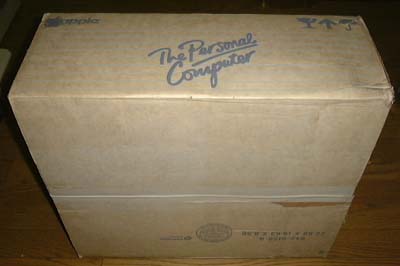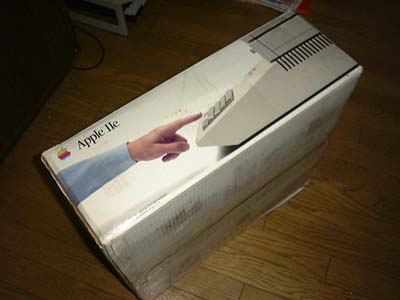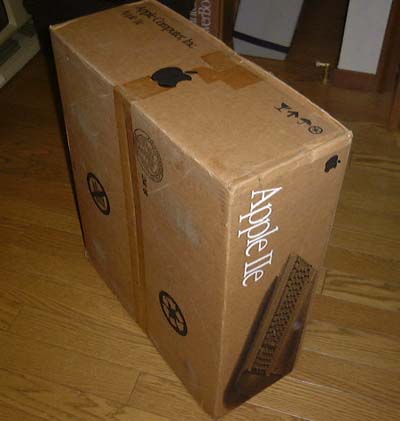
My appleII Notes-7
My AppleII Notes-7
99/8/08 An Apple Design on the Outer Box
The design of the outer box reflects its age, era background, and the progress of the packaging technology of personal computers. This is all very interesting to me. I tried to classify what I had at hand into four categories by age.
CATEGORY-1(1977〜1982)

|
|
1979 BELL & HOWELL APPLE II PLUS
|
CATEGORY-2(1983〜1984)

|
|
1983 APPLE IIE(UNENHANCED)
In this
period, the box becomes cardboard with slight whitening, and the lettering
of the outer box is mainly gray. The logo "The Personal Computer" is
printed in the box of the Apple IIe and on the Hand Controller II, and we
can see that Apple are conscious of their rival the IBM Personal Computer.
In addition to conventional cardboard and sponge, polystyrene is beginning
to be used as a cushioning material.
The above picture is of a package
that I borrowed from my friend Mr. Yoshiya Harada. It is an Apple IIe’s
packaging that he has been cherishing for many years. On the outer box,
model number A2S2064 in printed, which shows that this box belongs to the
Apple IIe 64K model.
Below are an Imagewriter that was
released in December 1983 and a Macintosh that was released in January
1984. On the box of the Macintosh, a somewhat familiar logo which was
designed by Tom Hughes and John Cassard, who were directors of art at that
time, along with a picture of a Macintosh, is boldly printed, but the
traditional Apple logo is not to be found. Macintosh packages are superb
in design and for small items each is designed especially. It may be more
appropriate to have them featured in a category separate to this one.
Also, the Apple IIc's packaging
released in April 1984 uses high quality paper with full-color printing.
During this transitional period, we can get a feel for the creativity and
work that went into the design of each product’s outer box.
Petroleum prices recorded a peak of $
36.9 per barrel in 1981, but at around 1983 it stabled somewhat. As for
materials, such as corrugated cardboard and polystyrene, in terms of price
and quality, it seems that the designer's range of choice was expanding.
|
CATEGORY-3(1985〜1986)

|
|
1985 APPLE IIE(ENHANCED)
In 1985, Apple Computer's logo type
also changed from "apple" to "Apple", and the font is changed from a short
and thick kind of typeface to a somewhat tall and smart one. In this
period, fine white cardboard is used, the product photo is printed on the
box, and a large Apple logo inserted. It is bright and luxurious.
The package design of the IIc, which
was an innovative red color disappeared after about a year and was
replaced by white. This meant the logotype changed, disk labels and
manuals changed, in fact the whole range changed to this new design based
on white. During this period, the structure of Apple was going through the
era of Steve Jobs and Sculley's Dynamic Duo, with it being consolidated by
Sculley. This internal change probably explains the choice in design
preferences.
In this period, it is thought that
the price of oil has stabilized worldwide, and the supply of fine
corrugated cardboard became relatively easy to access, thus the design of
the outer box became bright and luxurious. Meanwhile, as the diversified
product line increased Apple inventory this added pressure financially,
thus it seems that the company headed in a direction of rationalization by
standardization with respect to the design of the outer box. |
CATEGORY-4(1987〜 )
1987 Platinum Apple IIe
In the latter half of the 1980s, the
global environmental problem will be taken up as a major international issue
following the Toronto Summit in 1988. Through these meetings, industrial sectors
are required to improve energy utilization efficiency and protect forests. The
picture below is of the Apple IIe Platinum Model which was released in January
1987. This product is around 1993. Whether or not this box was used since the
release in 1987 is unconfirmed, but on the Macintosh line, if my memory is
correct, this type of box had been used since the release of the 1992 Macintosh
Duo.
Using recycled paper, large recycling
marks are also printed on the boxes.
